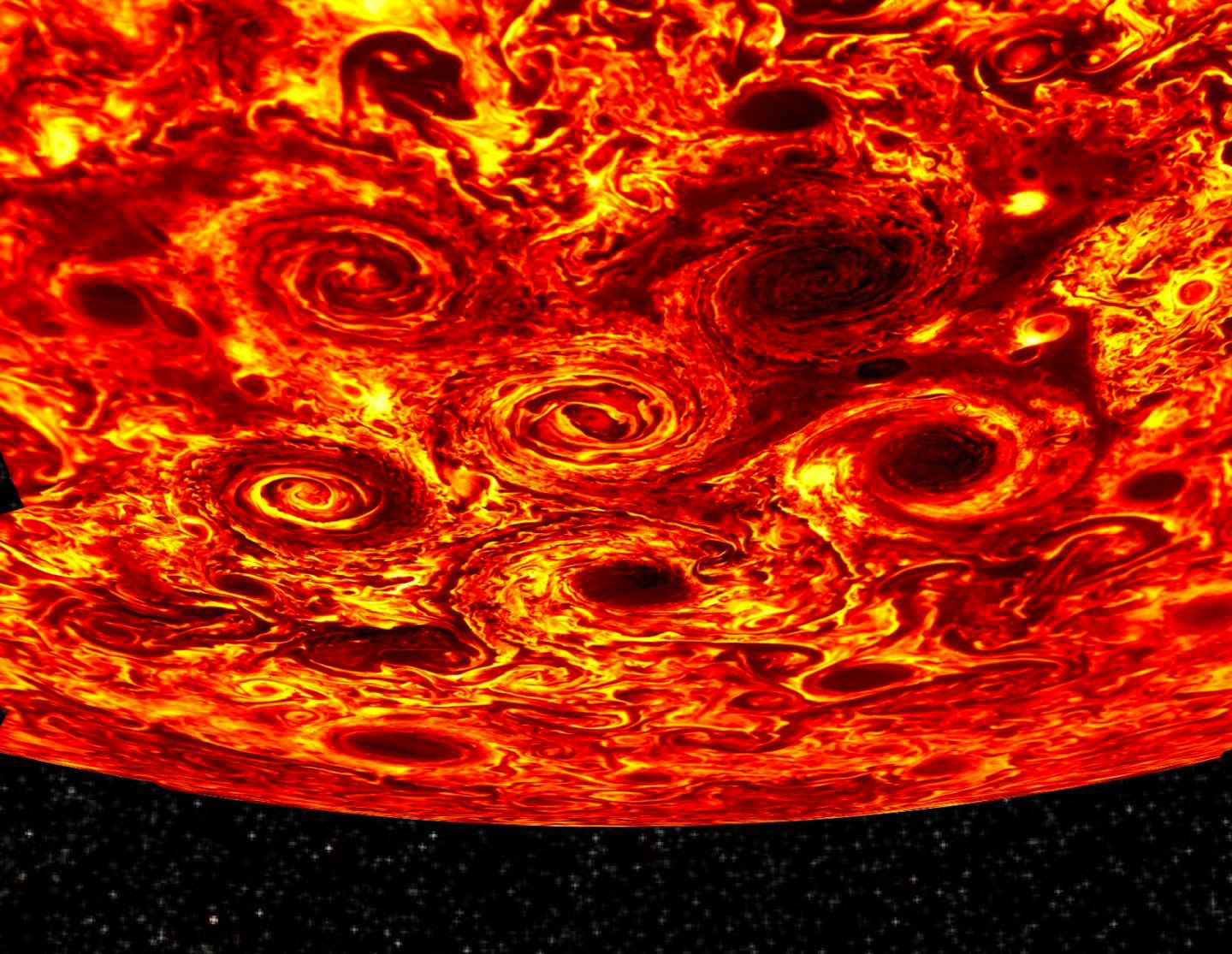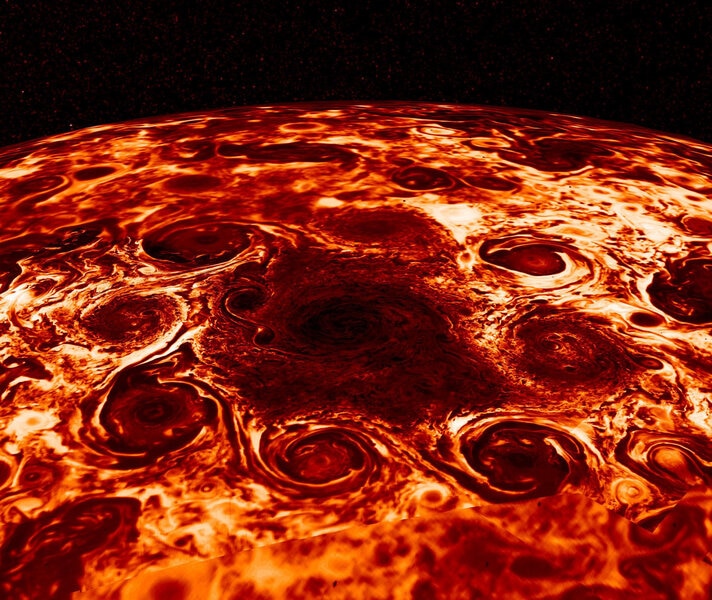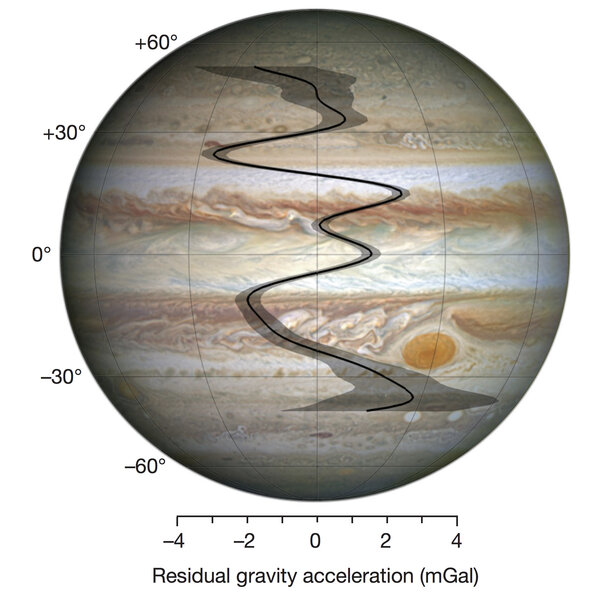Create a free profile to get unlimited access to exclusive videos, sweepstakes, and more!
Whoa, like, Jupiter is DEEP. Really, really deep.

Scientists studying Jupiter using data and observations from the Juno spacecraft just released four new papers on their results, and I honestly can't say what's cooler: the science, or the jaw-dropping images.
The research deals with Jupiter's atmosphere. Jupiter is a gas giant, and when we see it we're not looking at a surface at all, just the tops of its clouds. And even that is complicated, because the clouds are at all different heights. In some spots we see high-altitude clouds (sometimes shiny white due to ammonia ice that's frozen out as the gas rises) and in some spots we see hundreds of kilometers deeper.
But that's peanuts; Jupiter is 130,000 kilometers across! So we're really not seeing very far into it. That's why NASA sent the Juno spacecraft there. It uses a suite of instruments to analyze Jupiter's atmosphere, allowing scientists to gain an understanding of what's happening underneath the cloud tops. Not only that, but they put the probe on a polar orbit, meaning that instead of going around the planet's equator, the orbit is tilted nearly 90°, so it passes over both poles once per orbit. The orbit is also highly elliptical, so elongated that Juno goes out about 8 million kilometers from Jupiter, then swings back and dives to just 4,000 km over the north pole!
The data being returned is unprecedented. And what scientists are learning is… well, weird. As expected. Jupiter is a weird place.
And by weird, I mean holy-crap-what-the-heck-is-going-on-there?! weird. Behold, Jupiter's north pole!
I'll admit, when I first saw this image, it gave me the willies. There's something downright unsettling about it. But once I got past that, and really looked at it, that's when I really got the willies.
This image is a composite of several images taken using the Jupiter InfraRed Auroral Mapper, which can detect light in the thermal infrared. That means warmer gas is brighter, and cooler darker. The warmest gas in these images is about -10° C, and the coolest about -80°.
That dark (cool) swirl is the Northern Polar Cyclone (or NPC), a vortex about 4,000 kilometers across — that's the distance from Los Angeles to New York City! It's surrounded by cool gas, and around that is an entirely bizarre string of eight cyclones, all about the same size. At first I thought they formed an octagon, but a better description is two overlapping and rotated squares, each square made by connecting every other cyclone around the pole.
Start with the one in the lower left (let’s call it cyclone 1): See how it looks smoother, slightly bigger, and more organized than the ones on either side of it? Once you see that, you'll see that cyclones 3, 5, and 7 are similar, and that 2, 4, 6, and 8 are less organized, rougher. It turns out the two overlapping patterns are different in other ways; for example, the centers of the odd ones are at a latitude of 82.5, and the even ones a bit farther north at 83.3° — a difference of nearly 1,000 km!
Why? Well, yeah, that's a good question, and no one knows. It's common in planetary atmospheres to get cyclones near the poles; a complicated byproduct of the Coriolis effect pushes them poleward. But in most planets the cyclones merge when they get close, or dissipate. However, this octet of them (nonet if you include the NPC) was seen in the earliest Juno images and have persisted for at least seven months, far longer than you'd expect. They may even be older, since we don't know how long they were there before Juno arrived.
On Saturn, a similar effect created and sustains the oh-so-very-cool hexagonal pattern at its north pole. Why this hasn't happened on Jupiter is unknown.
Also weirdly, the south pole of Jupiter is different:
There's a single Southern Polar Cyclone (the SPC in this case), but only five cyclones around it! They're bigger too, and are different sizes, ranging from 5,600 to 7,000 km across. Again, it's not clear why the poles are different. The fact that there are fewer in the south and they're bigger may be related (I'm guessing, but if you have fewer they can grow to fill more space … ?), but no one really knows.
Not only have these features persisted for months, but during that time no new features appeared either. There's a lot more stability here than expected, and no one is sure why.
The weirdness extends to lower latitudes as well. I love this part, so bear with me. If Jupiter were a solid ball, it would rotate rigidly. But it's not; the atmosphere goes down quite a ways until the pressure squeezes it into something resembling a liquid, and then deeper down there may be a solid core. If you spin a spherical fluid and let it settle down into stable patterns, you get a predictable rotation to it versus depth. Any deviations from this are likely due to wind patterns taking cold, dense air deeper into the planet.
On the surface we see these wind patterns as the bright zones and dark belts stretching across it. But what happens deeper down? How far does the wind carry them into the planet?
It turns out that even though this happens far below the clouds, this can be measured! Denser layers will have slightly more gravity than less dense ones, and as Juno swings by close to the planet this variation in gravity is detectable as changes in its velocity. It's a small effect, sure, but detectable.
They found a few things. One is that the changes in gravity, and therefore density, are latitude-dependent and correlate strongly with the banding we see at the tops of the clouds. Given it's wind that changes the deep density and also sculpts those bands, that's not too surprising. Weirdly (that word gets used a lot with Jupiter) there's a north/south asymmetry; the two hemispheres have unequal distribution of mass. Why? Yeah, you guessed it: No one's sure.
Also, by comparing what they expect from just fluid rotation to what they measure with Juno, scientists can map how far down the winds carry these banded surface structures: about 3,000 kilometers.
Yegads. That's a long way. Jupiter's atmosphere is deep. At that depth, the winds and banding we see on the surface give way to more homogeneous structure, and under that Jupiter rotates nearly like a rigid ball.
The scientists studying this think that at that 3,000 km depth, the pressure and heat are so huge that the gas becomes a plasma, ionized, where the atoms of the gas have their electrons stripped from them. That means the plasma is electrically charged. When you move a charged gas it creates a magnetic field, so right around that depth there's a lot of magnetism. If one layer of gas is moving faster than another, their magnetic fields will interact and create drag, smoothing out their different speeds. Above that depth there's no magnetism to homogenize everything, so we see banding. Below that depth the magnetic fields don't allow any deviations from the bulk motion.
That's amazing. All this from a few flybys of a spacecraft thousands of kilometers above the cloud tops over half a billion kilometers from Earth!
Interestingly, that depth means that the atmosphere of Jupiter is equal to about 1% of its total mass. That's a big fraction; the Earth's atmosphere is less than a millionth of our planet’s total mass. And remember, Jupiter is ridiculous huge; even 1% of its mass is more than 3 times Earth's entire mass!
That is a lot of gas.
And that means a lot of mysteries, many more still to explore. Even with all this, all we've learned about this vast gasball, the Juno mission is only one-third done! There are still years left of observations yet to be made. Some will refine what we already know, honing the measurements already made. But what else is out there, what new things lurk in the 1.4 quadrillion cubic kilometers of weirdness that make up the largest planet in our solar system?
We're still finding out. Stick around. You'll see.

















